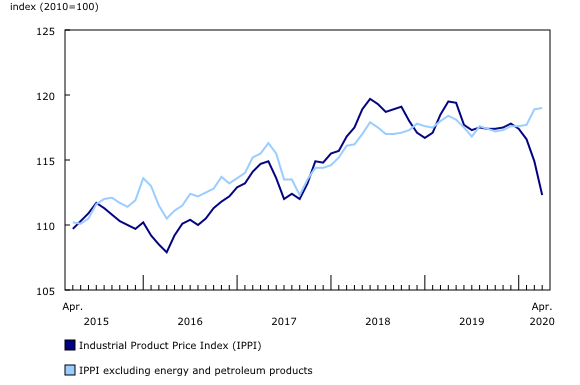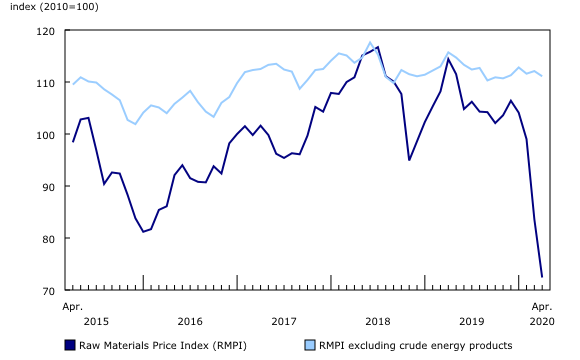Industrial product and raw materials price indexes, April 2020
Archived Content
Information identified as archived is provided for reference, research or recordkeeping purposes. It is not subject to the Government of Canada Web Standards and has not been altered or updated since it was archived. Please "contact us" to request a format other than those available.
Released: 2020-05-29
Prices for products manufactured in Canada, as measured by the Industrial Product Price Index (IPPI), fell 2.3% in April, mostly because of lower prices for refined petroleum products. Prices for raw materials purchased by manufacturers operating in Canada, as measured by the Raw Materials Price Index (RMPI), decreased 13.4%, primarily because of a drop in crude oil prices.
Industrial Product Price Index
The IPPI fell 2.3% on a month-over-month basis in April. This was a fourth consecutive monthly decrease and the largest decline since December 2008 (-2.6%). Although the IPPI was down in April, the decreases were isolated. Of the 21 major commodity groups, 14 were up, 5 were down and 2 were unchanged.
Lower prices for energy and petroleum products (-22.0%)—especially for refined petroleum energy products, and biofuels (-25.4%)—contributed the most to the decline in the IPPI. Motor gasoline (-30.6%) and, to a lesser extent, diesel fuel (-24.5%), light fuel oils (-22.4%) and jet fuel (-28.0%), drove this decrease. The decrease in energy and petroleum product prices was largely the result of an excess supply of petroleum, combined with falling global demand for refined petroleum products.
Chemicals and chemical products (-3.2%) also contributed to the decline in the IPPI, but to a lesser degree. Lower prices for petrochemicals (-25.4%), particularly aromatic hydrocarbon gases (-44.9%), were mainly responsible for the decrease in this commodity group. A sharp decline in prices for crude oil, the raw material used to produce aromatic hydrocarbon gases, led this decrease.
The IPPI excluding energy and petroleum products edged up 0.1%, mainly on higher prices for meat, fish and dairy products (+2.4%). Prices for fresh and frozen pork (+10.7%) and fresh and frozen beef and veal (+7.1%) were the primary sources of this gain. Slaughterhouse closures in Canada and the United States caused by the COVID-19 pandemic resulted in a decrease in the meat supply on the market, leading to higher prices.
Year over year, the IPPI fell 6.0%, mainly because of lower prices for energy and petroleum products (-44.8%).
Raw Materials Price Index
The RMPI fell 13.4% in April, following a sharp decline of 15.6% in March. This was the fourth consecutive monthly decrease. Of the six major commodity groups, four were down and two were up.
The decline in the RMPI from March was led by lower prices for crude energy products (-42.0%), especially conventional crude oil (-44.6%), which posted its largest monthly drop since the beginning of this series in January 1981.
From January to April 2020, prices for crude energy products fell 67.6%, mostly because of higher supply than demand for crude oil and an increase in inventories. Furthermore, the demand for oil collapsed because of the COVID-19 pandemic. According to estimates from the Energy Information Administration, since the beginning of 2020, global demand for oil has fallen 22.7%—down to 76.3 million barrels per day (mbpd) in April. In the same period, global supply of crude oil decreased by 2.0%, down to 99.1 mbpd.
The RMPI excluding crude energy products decreased 0.9%. Prices for animals and animal products posted a 2.3% decline. The main sources of the drop in this commodity group were prices for live animals (-4.1%), especially cattle and calves (-6.3%) and hogs (-3.2%). Decreased demand for live animals, created by reduced slaughterhouse capacity because of COVID-19, contributed to this decline. Slaughterhouse closures had opposing effects on meat prices in the IPPI and live animal prices in the RMPI. Because of reduced capacity, slaughterhouses bought fewer live animals, which caused prices for live animals to decrease. In turn, there was a lower supply of meat on the market, causing meat prices to increase.
Compared with April 2019, the RMPI decreased 36.7%, primarily because of lower prices for crude energy products (-72.8%).
Note to readers
The Industrial Product Price Index (IPPI) and the Raw Materials Price Index (RMPI) are available at the Canada level only. Selected commodity groups within the IPPI are also available by region.
With each release, data for the previous six months may have been revised. The indexes are not seasonally adjusted.
The Industrial Product Price Index reflects the prices that producers in Canada receive as goods leave the plant gate. The IPPI does not reflect what the consumer pays. Unlike the Consumer Price Index, the IPPI excludes indirect taxes and all costs that occur between the time a good leaves the plant and the time the final user takes possession of the good. This includes transportation, wholesale and retail costs.
Canadian producers export many goods. They often indicate their prices in foreign currencies, especially in US dollars, and these prices are then converted into Canadian dollars. In particular, this is the case for motor vehicles, pulp and paper products, and wood products. Therefore, fluctuations in the value of the Canadian dollar against its US counterpart affect the IPPI. However, the conversion to Canadian dollars reflects only how respondents provide their prices. This is not a measure that takes into account the full effect of exchange rates.
The conversion of prices received in US dollars is based on the average monthly exchange rate established by the Bank of Canada and available in table 33-10-0163-01 (series v111666275). Monthly and annual variations in the exchange rate, as described in the release, are calculated according to the indirect quotation of the exchange rate (for example, CAN$1 = US$X).
The Raw Materials Price Index reflects the prices paid by Canadian manufacturers for key raw materials. Many of those prices are set on the world market. However, as few prices are denominated in foreign currencies, their conversion into Canadian dollars has only a minor effect on the calculation of the RMPI.
Products
Statistics Canada has launched the Producer Price Indexes Portal as part of a suite of portals for prices and price indexes. This webpage provides Canadians with a single point of access to a variety of statistics and measures related to producer prices.
The video "Producer Price Indexes" is available on the Statistics Canada Training Institute webpage. It provides an introduction to Statistics Canada's producer price indexes—what they are, how they are made and what they are used for.
Real-time table
Real-time table 18-10-0248-01 will be updated on June 8.
Next release
The industrial product and raw materials price indexes for May will be released on June 29.
Contact information
For more information, or to enquire about the concepts, methods or data quality of this release, contact us (toll-free 1-800-263-1136; 514-283-8300; STATCAN.infostats-infostats.STATCAN@canada.ca) or Media Relations (613-951-4636; STATCAN.mediahotline-ligneinfomedias.STATCAN@canada.ca).
- Date modified:





